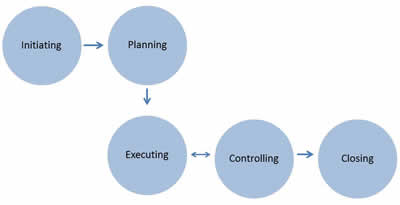 Professional Project managers divide projects into 5 steps. Initiating, Planning, Executing, Controlling, and Closing. These steps guide a project from conception to completion.
Professional Project managers divide projects into 5 steps. Initiating, Planning, Executing, Controlling, and Closing. These steps guide a project from conception to completion.
Private Project Management Training & Consulting
Initiating projects
Projects begin (usually with a project charter) when the goal is chosen. Is a building being built? An office being moved? A division being launched? Clearly word the goal in concrete, objective terms with a time-frame. Successful completion or failure of a project should be obvious; so trade out subjective terms, like “better” and “Improved” for measurable terms.
After the goal has been identified, the project can be initiated with the first of the five project management steps, project initiation. There are three primary steps to project initiation. Working through these steps may also refine the goal.
- Project Scope Definition– From a high level, what is included in the project? If the goal is to install lawn sprinklers, is replacing the water main also included? It may be easier to ask what is not included in the project. The details of the scope will be finalized in the planning phase.
- Project manager appointed– Someone, an individual, must be responsible for the success of the project. Whoever gets yelled at if things don’t go well is usually the project manager.
- What are the milestones? Milestones are the successes that have to happen along the way to successful completion of a project. In a sense, they are mini goals, or sub goals. Simple projects may not have any milestones, while complex projects will have many.
Planning Projects
The second project management step is planning the project. Much of the work of project management falls into the planning phase. Project plans are written documents that detail what is being done, and what is needed to do it. They are useful for detailed task planning (refinement of the scope), risk analysis, and definition of governance processes. Use the following steps to define a project plan.
- Start a Work Breakdown Structure (WBS)- The WBS is a list of the smaller components that are required for success with the overall project. The WBS includes 100% of the work defined by the project scope and captures all of the deliverables. The WBS is not a task list, but rather a list of desired outcomes.
- Estimate resources and time – Think through what’s needed and how much time is needed for each of the outcomes in the work breakdown structure. It may be helpful to give both optimistic and pessimistic estimates to help juggle deadlines and set expectations and project goals.
- Sequence of activities – Identify the order in which tasks need to be completed. This work is commonly handled through GANT charts with Microsoft Project Software.
- Implementation Schedule- the Project implementation schedule pulls together the WBS, Time and resource estimations, and sequence of activities are defined.
- Risk Analysis- Brainstorm all of the things that could blow the project off course, then prioritize them by how likely they are to occur, and the consequence of them occurring. Make contingency plans for addressing the most likely or most damaging risks.
- Resource Leveling – This is the process of matching what you want with what you have. Budgets, time, and resources are limited. Project plans need to account for that.
- Communication Systems- During the planning phase it may be helpful to set standards for when and how communication should occur. How often are the status reports? How should emergencies be reported?
A complete plan is very helpful in eliminating redundant work and organizing efforts.
Project execution and control
Project Management steps 3 and 4 are execution and control.
As a project is executed, inevitably, stuff comes up. Project Managers respond to changes in the business, the scope, the audience, or any number of other factors. Project Execution simply means that the tasks listed in the plan are accomplished in the way they were conceived. Good project controls ensures that this happens.
Status reports are a common way to control a project. At regular intervals or as milestones are achieved, status reports should be delivered to whoever is responsible for the ultimate success of the project.
It may be helpful to develop a standard temple for a status report. Complex projects justify more in depth status reports than simple projects.
Closing a Project
The last project management step is closing the project.
Projects should be formally closed by writing a summary of the project. With good documentation, writing the report shouldn’t be too time consuming, and it can be very beneficial. The report should include the following:
- Notes on successful completion of each milestone.
- Changes in the scope of work
- The differences between the budgeted resources and the actual resources needed
- The impact of the project
- Lessons learned










